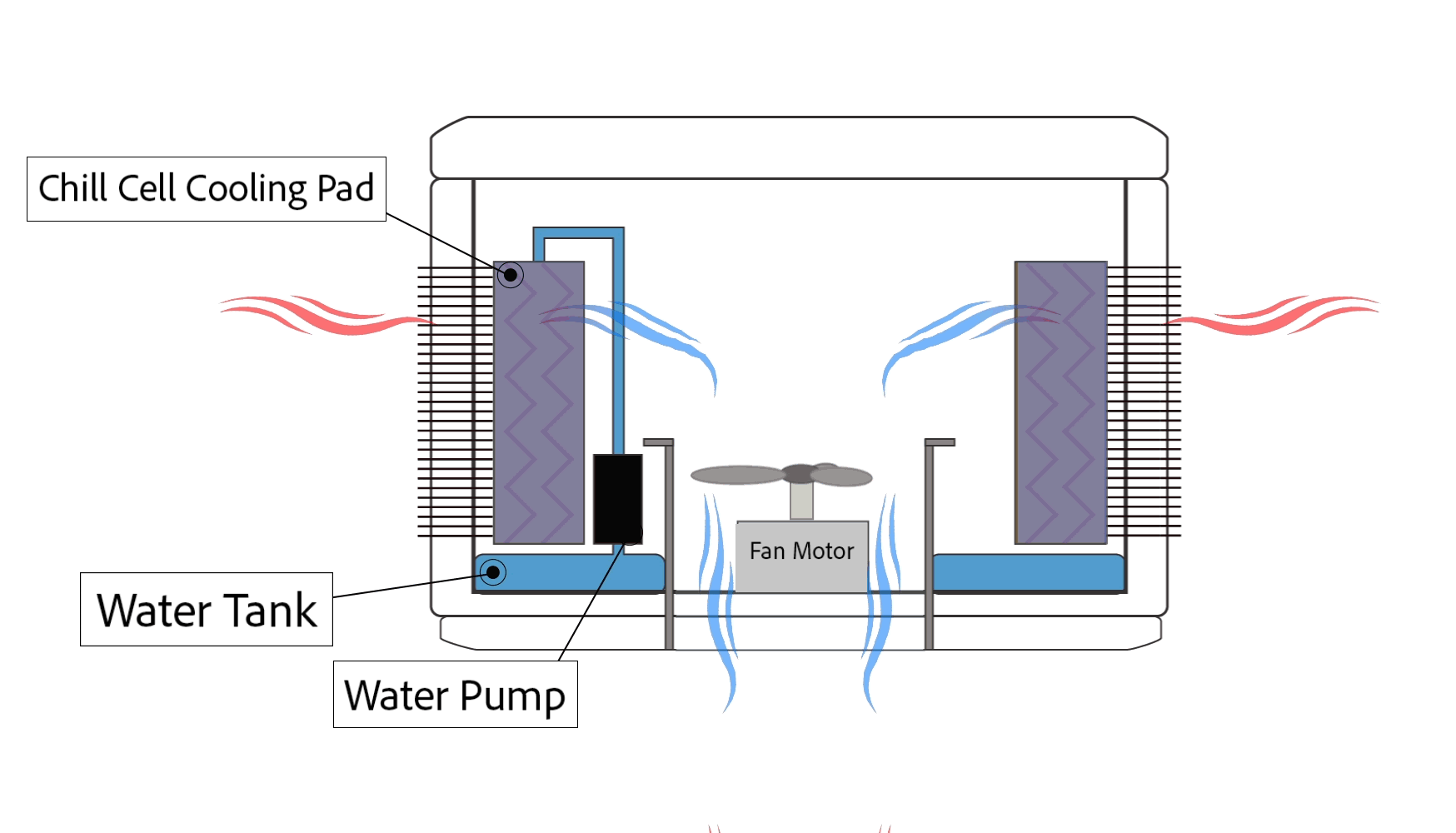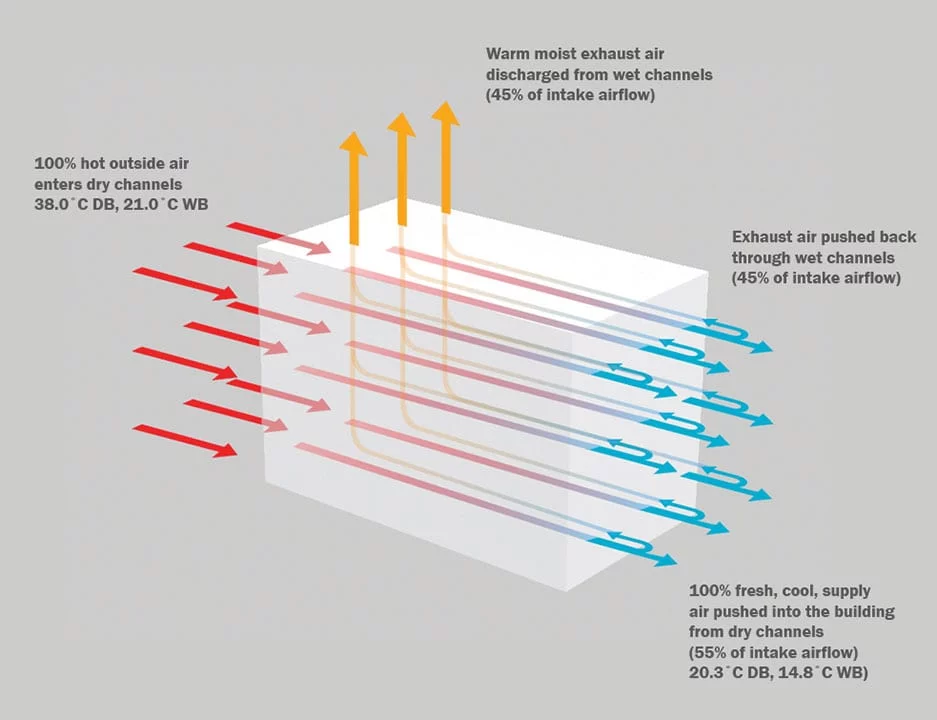Evaporative Cooling
NATURAL AIR CONDITIONING = 100% FRESH AIR
Evaporative cooling uses the natural principle of water evaporation to lower the temperature of the environment. This solution requires little energy, which contributes to a radical reduction in air conditioning costs.
The diagram below illustrates the operation of evaporative air conditioning in industrial rooms:


Balanced flow ensures the highest evaporation and cooling efficiency, and the key to effective evaporative cooling is to ensure optimal water saturation of the cooling pads at all times.
The only electrical devices in a Seeley air conditioner are a fan and a small water pump. Natural cooling uses up to 87% less energy than conventional air conditioning . It provides 100% fresh outside air (without recirculation), and uses pure water for cooling instead of synthetic, chemical refrigerants (CFC, HFC and HCFC). It does not emit pollutants and water consumption is moderate. These advantages make natural air conditioning the best solution for companies: by creating a pleasant working environment, you can maximize productivity while minimizing costs.
Choosing natural evaporative air conditioning brings benefits unheard of in other air conditioning technologies:
- Operating costs up to 87% lower than in the case of conventional air conditioning,
- Ecological technology,
- No dangerous chemical refrigerants (only water is used for cooling),
- 100% fresh air , without recirculation - reduces the risk of "sick building" syndrome,
- Easy installation and maintenance,
- Australian quality and international technical support.

Direct Evaporative Cooling
In direct evaporative coolers, hot outside air is drawn through water-soaked cooling pads. As the air is pushed through these pads, water evaporates and heat in the air is absorbed, which lowers the air temperature. A fan then pushes the cool air throughout the building via a network of ducts. It is called direct evaporative cooling because the air is directly cooled thanks to water evaporation.
Compared to other climate control systems available, evaporative air cooling provides the most energy efficient temperature relief for commercial or industrial environments of any scale.
Up to 80% more economical than conventional air conditioning systems, our evaporative cooling systems have delivered proved cost reductions and operational returns throughout many industries.
Unlike air conditioning that use re-circulated air, evaporation systems circulate fresh air through a building and force out the stale hot air.
Indirect Evaporative Cooling
Indirect evaporative air conditioners use a hyper-efficient heat exchanger to produce 100% fresh, cool, outside air, with no added moisture. The fresh cold air produced by indirect evaporative coolers can be similar to that produced by refrigerated systems, with temperatures that approach the ambient dew-point temperature, using up to 80% less energy.
No matter how hot it gets outside, indirect evaporative coolers use the same amount of power and still delivers 100% fresh, cool air inside. This is in direct contrast to refrigerated systems, which require increasing amounts of power as outside temperatures rise. Indirect evaporative coolers’ cost-saving capabilities actually increase, when the heat is at its highest. At the same time, their performance also increases as temperatures rise – again, in complete contrast to refrigerated systems.
It is for ideal for use as a DOAS (dedicated outdoor air system), data centre cooling or for comfort cooling applications. Indirect evaporative coolers cover an exceptionally large range of flexible configurations in a wide range of industries.
HOW DOES WORK?
Indirect evaporative air conditioners use a hyper-efficient heat exchanger to produce 100% fresh, cool, outside air, with no added moisture. The core is an air-to-air heat exchanger consisting of alternating dry and wet channels.
- Hot outside air enters the cooler and the fan drives the fresh air through the dry channels.
- On exiting, some of the air flows into the building and the remainder is forced back through the wet channels.
- Air passing through the wet channels is cooled by water evaporation and cools the channel surface, before being exhausted as warm, moist air.
- The temperature of the fresh air passing through the adjacent dry channels is reduced and this cooled air is then transferred into the building without any added moisture.

FAQs-Evaporative cooling
Because the air being pumped in collects heat and moisture and impurities from inside the building and it must therefore be exhausted. The Evaporative Air Conditioner does NOT recirculate the inside air, and if you close the building the effectiveness of the machine will be greatly diminished and you will become very uncomfortable.
Your Dealer is trained to work with you to select the correct model and quantity of Evaporative Air Conditioners for your project. Often multiple machines are required. The calculations may be made on the basis of the Heat Load in your building, or on the basis of the required Air Changes per hour for your locality. The calculation is based on traditional air conditioning practice and is completely transparent to anyone who wants more information.
It uses the natural principle of cooling by evaporation. Wet your finger and hold it in the air and it becomes cool; that is because evaporation is occurring; it is a natural phenomenon. In the Evaporative Air Conditioner a pump circulates water through a set of cooling pads through which air is forced by a motor driven fan. The hot outside air passing through the pads evaporates the water in the wetted pads at a very high rate. This cools the air which is then pumped into your building.
In most cases, it does slightly. BUT remember that the temperature has also dropped. It is the combination of temperature and humidity that creates human comfort, and Evaporative Air Conditioners are used so widely around the world because they can create comfortable conditions. For example, 80% humidity and 30 C is very uncomfortable, but 80% humidity and 16 C is quite comfortable. Furthermore, comfort is also improved by increasing air velocity in hot conditions and Evaporative Air Conditioners create sufficient air movement to also minimise the effects of humidity.


